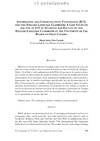Identificador persistente para citar o vincular este elemento:
https://accedacris.ulpgc.es/jspui/handle/10553/7473
| Campo DC | Valor | idioma |
|---|---|---|
| dc.contributor.author | Vera-Cazorla, María J. | en_US |
| dc.date.accessioned | 2012-05-30T04:00:27Z | |
| dc.date.accessioned | 2018-03-14T08:00:17Z | - |
| dc.date.available | 2012-05-30T04:00:27Z | |
| dc.date.available | 2018-03-14T08:00:17Z | - |
| dc.date.issued | 2010 | en_US |
| dc.identifier.issn | 0213-0610 | en_US |
| dc.identifier.uri | https://accedacris.ulpgc.es/handle/10553/7473 | - |
| dc.description.abstract | While students are increasing their use of emerging technologies such as text messaging, wikis, social networks and other interactive web services such as Facebook, MySpace, Flickr and YouTube and other Web 2.0 applications, this is not the case with many university faculty. This phenomenon has important implications for educational institutions. We assume that the technological change introduced by Web 2.0 tools has caused a cultural change in terms of dealing with types of communication, knowledge and learning. The purpose of this study is to assess English II students and faculty’s use and awareness of the benefits of Web 2.0 to supplement in-class learning. | en_US |
| dc.description.abstract | Mientras el uso de las nuevas tecnologías tales como los mensajes de texto, laswikis, las redes sociales y otros servicios interactivos como el Facebook, MySpace,Flickr y YouTube y otras aplicaciones de la Web 2.0 por parte de nuestros alum-nos es cada vez más común, no ocurre lo mismo en el caso de muchos profesoresuniversitarios. Este fenómeno tiene importantes implicaciones a nivel educativo.Suponemos que el cambio tecnológico introducido por las herramientas de laWeb 2.0 ha acarreado un cambio cultural al tratar con distintos tipos de comu-nicación, conocimiento y aprendizaje. El propósito de este trabajo es evaluar eluso de los recursos de internet por parte de los alumnos y profesores de LenguaInglesa II así como su opinión sobre los beneficios de la Web 2.0 para comple-tar el aprendizaje de dentro del aula. | en_US |
| dc.format | application/pdf | es |
| dc.language | eng | en_US |
| dc.relation.ispartof | El Guiniguada | en_US |
| dc.source | El Guiniguada [ISSN 0213-0610], n. 19, p. 211-226 | en_US |
| dc.subject | 58 Pedagogía | en_US |
| dc.subject.other | ICT | en_US |
| dc.subject.other | TIC | en_US |
| dc.subject.other | Nivel universitario | en_US |
| dc.subject.other | Enseñanza de idiomas extranjeros | en_US |
| dc.subject.other | Foreign languages teaching | en_US |
| dc.subject.other | University students | en_US |
| dc.title | Information and communication technology (ICT) and the english language classroom: a case study on the use of ICT by students and faculty in the english language classroom at the University of Las Palmas de Gran Canaria | en_US |
| dc.type | info:eu-repo/semantics/article | en_US |
| dc.type | Article | en_US |
| dc.compliance.driver | 1 | es |
| dc.identifier.absysnet | 235347 | - |
| dc.identifier.crisid | 1407 | |
| dc.description.lastpage | 226 | en_US |
| dc.description.firstpage | 211 | en_US |
| dc.investigacion | Artes y Humanidades | en_US |
| dc.rights.accessrights | info:eu-repo/semantics/openAccess | es |
| dc.type2 | Artículo | en_US |
| dc.utils.revision | Sí | en_US |
| dc.identifier.supplement | 1407 | - |
| dc.identifier.supplement | 1407 | - |
| dc.identifier.ulpgc | Sí | en_US |
| dc.contributor.buulpgc | BU-EGB | en_US |
| dc.description.sellofecyt | Sello FECYT | |
| dc.description.esci | ESCI | |
| dc.description.erihplus | ERIH PLUS | |
| item.fulltext | Con texto completo | - |
| item.grantfulltext | open | - |
| crisitem.author.dept | GIR Estudios sociolingüísticos y socioculturales | - |
| crisitem.author.dept | Departamento de Filología Moderna, Traducción e Interpretación | - |
| crisitem.author.orcid | 0000-0002-0210-030X | - |
| crisitem.author.parentorg | Departamento de Filología Moderna, Traducción e Interpretación | - |
| crisitem.author.fullName | Vera Cazorla, María Jesús | - |
| Colección: | Guiniguada. 2ª Etapa. n.19, 2010 Artículos | |
Visitas
193
actualizado el 09-nov-2024
Descargas
176
actualizado el 09-nov-2024
Google ScholarTM
Verifica
Comparte
Exporta metadatos
Los elementos en ULPGC accedaCRIS están protegidos por derechos de autor con todos los derechos reservados, a menos que se indique lo contrario.
